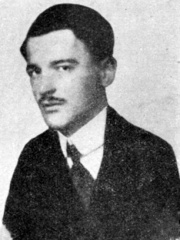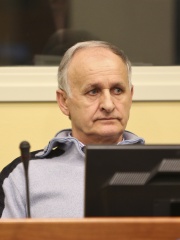



The Most Famous
EXTREMISTS from Bosnia and Herzegovina
This page contains a list of the greatest Bosnian, Herzegovinian Extremists. The pantheon dataset contains 283 Extremists, 4 of which were born in Bosnia and Herzegovina. This makes Bosnia and Herzegovina the birth place of the 15th most number of Extremists behind India, and Türkiye.
Top 4
The following people are considered by Pantheon to be the most legendary Bosnian, Herzegovinian Extremists of all time. This list of famous Bosnian, Herzegovinian Extremists is sorted by HPI (Historical Popularity Index), a metric that aggregates information on a biography's online popularity.

1. Gavrilo Princip (1894 - 1918)
With an HPI of 80.84, Gavrilo Princip is the most famous Bosnian, Herzegovinian Extremist. His biography has been translated into 88 different languages on wikipedia.
Gavrilo Princip (Serbian Cyrillic: Гаврило Принцип, pronounced [ɡǎʋrilo prǐnt͡sip]; 25 July 1894 – 28 April 1918) was a Bosnian Serb student who assassinated Archduke Franz Ferdinand, heir presumptive to the throne of Austria-Hungary, and his wife Sophie, Duchess von Hohenberg, in Sarajevo on 28 June 1914. The assassination set off the July Crisis, a series of events that within one month led to the outbreak of World War I. Princip was born in western Bosnia to a poor Serb family. Aged 13, he was sent to Sarajevo, the capital of Austrian-occupied Bosnia, to study at the Merchants' School. He later transferred to the gymnasium, where he became politically aware. In 1911, he joined Young Bosnia, a secret local society aiming to free Bosnia from Austrian rule and achieve the unification of the South Slavs. After attending anti-Austrian demonstrations in Sarajevo, he was expelled from school and walked to Belgrade, Serbia, to continue his education. During the First Balkan War, Princip traveled to Southern Serbia to volunteer with the Serbian army's irregular forces fighting against the Ottoman Empire but was rejected for being too small and weak. He also suffered from tuberculosis which was untreatable at the time and might have played a role in his motivation for the assassination. In 1913, following the unexpected success of the Serbians in the war against the Ottomans, the Austrian military governor of Bosnia, Oskar Potiorek, declared a state of emergency, dissolved the parliament, imposed martial rule, and banned Serbian public, cultural, and educational societies. Inspired by assassination attempts against Imperial officials by Slavic nationalists and anarchists, Princip persuaded two other young Bosnians to join a plot to assassinate the heir to the Habsburg Empire during his announced visit to Sarajevo. The Black Hand, a Serbian secret society with ties to Serbian military intelligence, provided the conspirators with weapons and training before facilitating their re-entry into Bosnia. On Sunday 28 June 1914, during the royal couple's visit to Sarajevo, the then-teenager Princip mortally wounded Franz Ferdinand and his wife Sophie, Duchess von Hohenberg, by firing a pistol into their convertible car. Princip was arrested immediately by Austro-Hungarian authorities and tried alongside 24 others, all Bosnians and thus Austro-Hungarian subjects. At his trial, Princip stated: "I am a Yugoslav nationalist, aiming for the unification of all Yugoslavs, and I do not care what form of state, but it must be free from Austria." Princip was spared the death penalty because of his age (19) and sentenced to twenty years in prison. He was imprisoned at the Terezín fortress. The Serbian government itself did not inspire the assassination but the Austrian Foreign Office and Army used the murders as a reason for a preventive war which led directly to World War I. Princip died on 28 April 1918 of tuberculosis, worsened by harsh prison conditions, that had already led to the amputation of his right arm. His legacy is viewed as controversial; many Serbs regard him as a hero who stood against colonial oppression and slavery, while Bosniaks and Croats frequently view him as a terrorist.

2. Nedeljko Čabrinović (1895 - 1916)
With an HPI of 69.31, Nedeljko Čabrinović is the 2nd most famous Bosnian, Herzegovinian Extremist. His biography has been translated into 24 different languages.
Nedeljko Čabrinović (Serbian Cyrillic: Недељко Чабриновић; 1 February 1895 – 23 January 1916) was a Bosnian Serb typesetter and political activist, known for his role in the assassination of Archduke Franz Ferdinand in Sarajevo on 28 June 1914. A member of Young Bosnia, a nationalist revolutionary group advocating for the unification of South Slavs, he was one of six conspirators involved in the assassination attempt. During the attack, Čabrinović threw a hand grenade at the Archduke's motorcade, but the explosive missed its target and detonated beneath the following vehicle. He was apprehended shortly after and later convicted of high treason. Since he was under 21, he was ineligible for the death penalty and received a twenty-year sentence of hard labour at the Theresienstadt fortress in Bohemia. While in prison, he endured harsh conditions and contracted tuberculosis, leading to his death on 23 January 1916. Following World War I, his remains were reinterred in Sarajevo alongside other conspirators in the Vidovdan Heroes Chapel.

3. Dinko Šakić (1921 - 2008)
With an HPI of 62.72, Dinko Šakić is the 3rd most famous Bosnian, Herzegovinian Extremist. His biography has been translated into 16 different languages.
Dinko Šakić (Croatian pronunciation: [dîːŋko ʃǎkit͡ɕ]; 8 September 1921 – 20 July 2008) was a Croatian Ustaše official, and convicted war criminal, who commanded the Jasenovac concentration camp in the Independent State of Croatia (NDH) from April to November 1944, during World War II. Born in the village of Studenci, near the town of Imotski in what was then the Kingdom of Serbs, Croats and Slovenes, he became a member of the fascist Ustaše at a young age. When the Axis powers occupied the Kingdom of Yugoslavia in April 1941, Šakić, aged 19, joined the administration in Jasenovac. He became the camp's assistant commander the following year, and married Nada Luburić, the half-sister of concentration camp commander Vjekoslav "Maks" Luburić, in 1943. This marriage, as well as his fanatic support for Ustaše leader Ante Pavelić, led to Šakić's appointment as commander of Jasenovac in April 1944. He was charged in the deaths of an estimated 2,000 people who died during his six months of command at the concentration camp. In 1945, Šakić and his wife fled the Independent State of Croatia alongside other Ustaše officials following the collapse of the NDH and Nazi Germany. They emigrated to Argentina in 1947, where Šakić started a textile business, was an active member of the country's 10,000-strong Croat community, and became friends with Paraguayan dictator Alfredo Stroessner. He lived an otherwise quiet life and made no effort to hide his identity. In 1990, the Feral Tribune interviewed Šakić for a magazine article and published his picture. Šakić met Croatian President Franjo Tuđman at a reception in Buenos Aires during the latter's visit to Argentina in 1994 and was interviewed by a Croatian publication called Magazin soon afterwards. He stated in the interview that he wished more Serbs had been killed in Jasenovac, saying that he would "do it all again" and added that he "slept like a baby". In March 1998, Šakić was interviewed by Argentine national television. He admitted to having been in a leadership position at Jasenovac but denied that anyone had been killed there during this time, claiming that all of those who perished had died from disease. The interview was broadcast across the nation the following month. It caused an uproar and caused Argentine president Carlos Menem to call for Šakić's arrest. Šakić disappeared soon after and was not arrested until May 1998. He was extradited to Croatia, where he was tried, found guilty of war crimes and crimes against humanity in October 1998 and sentenced to 20 years in prison. Šakić called the charges politically motivated and described himself as a Croatian patriot who only wanted to defend his country. Šakić was imprisoned in Lepoglava Prison and kept in a cell equipped with a television set and a computer for him to write his memoirs. He was allowed to visit his wife, who had been placed in a home for the elderly, several times a month. He died of heart problems in a Zagreb hospital on 20 July 2008 and was later cremated in full Ustaše uniform, as per his wishes.

4. Radislav Krstić (b. 1948)
With an HPI of 59.61, Radislav Krstić is the 4th most famous Bosnian, Herzegovinian Extremist. His biography has been translated into 16 different languages.
Radislav Krstić (Serbian Cyrillic: Радислав Крстић; born 15 February 1948) is a former Bosnian Serb Deputy Commander and later Chief of Staff of the Drina Corps of the Army of Republika Srpska (the "Bosnian Serb army") from October 1994 until 12 July 1995. He was promoted to the rank of major general in June 1995 and assumed command of the Drina Corps on 13 July 1995. In 1998 Krstić was indicted for war crimes by the International Criminal Tribunal for the Former Yugoslavia in The Hague in connection with the genocide of around 8,000 Bosniak prisoners of war and civilians on 11 July 1995 during the Srebrenica massacre – Europe's first genocide since World War II. On 2 August 2001, Krstić became the first man convicted of genocide by the Tribunal, and was sentenced to 46 years in prison. He was only the third person ever to have been convicted under the 1948 Convention on the Prevention and Punishment of the Crime of Genocide. The sentence was subsequently shortened to 35 years in prison when an appeal court upheld a lesser charge for aiding and abetting genocide.
People
Pantheon has 4 people classified as Bosnian, Herzegovinian extremists born between 1894 and 1948. Of these 4, none of them are still alive today. The most famous deceased Bosnian, Herzegovinian extremists include Gavrilo Princip, Nedeljko Čabrinović, and Dinko Šakić.
Deceased Bosnian, Herzegovinian Extremists
Go to all RankingsGavrilo Princip
1894 - 1918
HPI: 80.84
Nedeljko Čabrinović
1895 - 1916
HPI: 69.31
Dinko Šakić
1921 - 2008
HPI: 62.72
Radislav Krstić
1948 - Present
HPI: 59.61
Overlapping Lives
Which Extremists were alive at the same time? This visualization shows the lifespans of the 3 most globally memorable Extremists since 1700.

